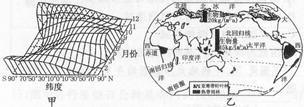(26分)读一年内到达大气上界的太阳辐射的纬向分布示意图(图甲)和热带雨林和亚寒带针叶林生物量的差异图(图乙),回答下列问题。

小题1:图甲中,纵剖面表示某一 太阳辐射随 的变化情况,据图可知,90°N最大的太阳辐射出现在 月份前后。
小题2:全球太阳辐射的纬度分布规律是从 向 递减。
小题3:3月~9月,南极附近地区太阳辐射非常少,而北极地区却又特别多。请分析其原因:
。
小题4:图乙中两种植被相比, 的生物量大,产生的原因是
。
小题5:太阳辐射的能量来源于太阳内部的 ,在这个过程中,太阳的 出现亏损,它转化成为 。
小题1:纬度 时间 6(或7月)
小题2:低纬 高纬
小题3:南极附近地区多处在极夜期,太阳高度小,光照时数少;而北极附近地区多处在极昼期,太阳高度大,光照时数多。
小题4:热带雨林 与热带雨林所处的纬度有关。热带雨林分布在赤道附近,终年太阳高度角大,接受太阳辐射多,光合作用强。
小题5:核聚变反应质量 能量
太阳辐射对地理环境的形成起着重要作用,太阳辐射不均匀的分布,是地球上热带、温带和寒带气候分异的根本原因,由此形成了不同的环境。生物量的多少是不同环境特征的明显反映。
